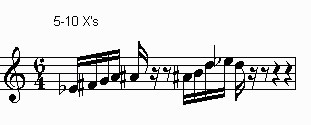
I am certain that most of us have practiced technical passages using the standard old technique of repeating a particularly tricky phrase over and over, setting the metronome at a tempo one-third of the ultimate tempo, then gradually moving the metronome speed up notch by notch until we played the passage perfectly at the desired performance tempo.
I submit that there may be an equally effective, but more efficient method of practicing: practice at the ultimate tempo from the outset.
Although a particularly awkward passage may require once or twice through to figure out the notes, I suggest that the passage then be broken down into short fragments and practiced rhythmically and up to tempo. The primary reason for this method of practicing is increased efficiency, for the simple reason that you will be able to play twice as many repetitions of the passage at full speed as you will at half speed.
Learning a new motor skill (such as mastering a troublesome phrase in a new etude) is directly related to the total number of correct repetitions that is recorded in our sub-conscious memory. The important keyword here is: correct repetitions. Obviously, we will not be able to initially play through the entire phrase up to tempo without errors. Therefore it will be necessary to start with motivic fragments which are short enough that they can be played without any errors. From that point, it will be possible to extend the length of the fragment and to combine adjacent fragments into larger units.
Here is a particularly tricky passage from a work for trumpet and band by the Hungarian composer, Kamillo Lendvay, the tempo is Presto:

It will be necessary to play through the passage a couple of times slowly, to be certain you are playing all of the notes correctly in this unusual scale pattern. However, I would suggest that the most efficient way of practicing this passage is to break it down into small parcels which you master by numerous repetitions at performance tempo (quarter note = 160). After each short fragment is mastered, they can be combined into larger fragments. For example:
 |
then |  |
| followed by | ||
 |
then finally |  |
This practice technique would be much easier to demonstrate in person than it is to describe in writing, but you should be able to perceive the basic nature of my method. I find that in general, most difficult passages can be learned in less time that by starting slowly and gradually increasing the tempo by small increments.
Back to Trumpet Topics Home Page
Back to Bryan Goff's Home Page
E-mail: bgoff@fsu.edu